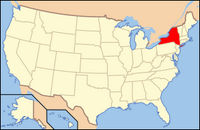| ||||||||||||||
| Cattaraugus County, New York | |
 Location in the state of New York (state) | |
 New York's location in the U.S. | |
| Founded | 1808 |
|---|---|
| Seat | Little Valley |
| Area - Total - Land - Water |
1,310 sq mi (3,393 km²) 12 sq mi (31 km²), 1.21% |
| Population - (2000) - Density |
83,955 65/sq mi (25/km²) |
| Website | www.co.cattaraugus.ny.us |
Cattaraugus County is a county located in the U.S. state of New York. As of the 2000 census, the population was 83,955. The county name comes from a Seneca Indian word meaning "bad smelling banks," referring to the odor of natural gas which leaked from seams in rock formations. The county seat is Little Valley.
History
When counties were established in New York State in 1683, the present Cattaraugus County was part of Albany County. This was an enormous county, including the northern part of New York State as well as all of the present State of Vermont and, in theory, extending westward to the Pacific Ocean. This county was reduced in size on July 3, 1766 by the creation of Cumberland County, and further on March 16, 1770 by the creation of Gloucester County, both containing territory now in Vermont.
On March 12, 1772, what was left of Albany County was split into three parts, one remaining under the name Albany County. One of the other pieces, Tryon County, contained the western portion (and thus, since no western boundary was specified, theoretically still extended west to the Pacific). The eastern boundary of Tryon County was approximately five miles west of the present city of Schenectady, and the county included the western part of the Adirondack Mountains and the area west of the West Branch of the Delaware River. The area then designated as Tryon County now includes 37 counties of New York State. The county was named for William Tryon, colonial governor of New York.
In the years prior to 1776, most of the Loyalists in Tryon County fled to Canada. In 1784, following the peace treaty that ended the American Revolutionary War, the name of Tryon County was changed to Montgomery County in honor of the general, Richard Montgomery, who had captured several places in Canada and died attempting to capture the city of Quebec, replacing the name of the hated British governor.
Ontario County was split from Montgomery County in 1789. In turn, Genesee County was split from Ontario County in 1802. Shortly afterwards, Genesee County was made smaller in 1806, by the creation of Allegany County.
Cattaraugus County was formed in 1808, split off from Genesee County. However, at first there was no county government due to the sparse population. From 1812 to 1814, Cattaraugus County was incorporated in Allegany County; from 1814 to 1817, records of the county were divided between Belmont (Allegany County) and Buffalo (then in Niagara County). Finally, in 1817, a county government was established for Cattaraugus County.
The first settlement in the county was in Olean and the original county seat was Ellicottville. After 1860, the county seat was moved to Little Valley.
Geography
Cattaraugus County is in the southwestern part of the state, immediately north of the Pennsylvania border. The southern part of Cattaraugus County is the only area of western New York that was not covered by the last ice age glaciation and is noticeably more rugged than neighboring areas that had peaks rounded and valleys filled by the glacier. The entire area is actually a dissected plateau of Pennsylvanian and Mississippian age, but appears mountainous to the casual observer. The plateau is an extension of the Allegany Plateau from nearby Pennsylvania. Southern Cattaraugus County is part of the same oil field, and petroleum was formerly a resource of the area. It is now mostly played out, but natural gas continues to be extracted.
According to the U.S. Census Bureau, the county has a total area of 3,425 km² (1,322 sq mi). 3,392 km² (1,310 sq mi) of it is land and 32 km² (12 sq mi) of it (0.94%) is water.
The northern border of the county is formed by Cattaraugus Creek.
Adjacent Counties
- Erie County - north
- Wyoming County - northeast
- Allegany County - east
- McKean County - southeast
- Warren County - southwest
- Chautauqua County - west
Major Highways
Interstate 86/New York State Route 17 (Southern Tier Expressway)
 U.S. Route 62
U.S. Route 62U.S. Route 219
New York State Route 16
New York State Route 98
New York State Route 240
New York State Route 242
New York State Route 353
Demographics
As of the census² of 2000, there were 83,955 people, 32,023 households, and 21,647 families residing in the county. The population density was 25/km² (64/sq mi). There were 39,839 housing units at an average density of 12/km² (30/sq mi). The racial makeup of the county was 94.63% White, 1.06% Black or African American, 2.60% Native American, 0.46% Asian, 0.02% Pacific Islander, 0.23% from other races, and 1.01% from two or more races. 0.94% of the population were Hispanic or Latino of any race. 26.8% were of German, 13.2% Irish, 11.3% English, 9.1% Polish, 8.2% Italian and 7.4% American ancestry according to Census 2000.
There were 32,023 households out of which 32.10% had children under the age of 18 living with them, 52.30% were married couples living together, 10.80% had a female householder with no husband present, and 32.40% were non-families. 26.80% of all households were made up of individuals and 11.60% had someone living alone who was 65 years of age or older. The average household size was 2.52 and the average family size was 3.05.
In the county the population was spread out with 26.20% under the age of 18, 9.30% from 18 to 24, 26.50% from 25 to 44, 23.50% from 45 to 64, and 14.60% who were 65 years of age or older. The median age was 37 years. For every 100 females there were 95.90 males. For every 100 females age 18 and over, there were 92.50 males.
The median income for a household in the county was $33,404, and the median income for a family was $39,318. Males had a median income of $30,901 versus $22,122 for females. The per capita income for the county was $15,959. About 10.00% of families and 13.70% of the population were below the poverty line, including 18.60% of those under age 18 and 9.90% of those age 65 or over.
Politics
Cattaraugus County is run by a unicameral legislature with an appointed county "administrator," who serves many executive duties of a county executive but has no legislative veto power and is not elected. The legislators themselves are independently elected (while some also serve as mayors of the villages they represent, their status as mayors does not affect in any way their seats on the legislature). The votes of each legislator are counted in proportion to the number of people that said legislator represents (for example, if a legislator from Olean has 10,000 people in his district, and the legislator serving Lyndon only has 5,000, the Lyndon legislator's vote has only half the worth of the Olean legislator's). There are currently 21 members of the legislature; the county is in the process of reducing that number to 17. Each legislator serves a four year term, with a limit of three terms.
The legislature is a majority Republican, with Crystal Abers serving as chairwoman. There are three represented parties in the legislature: Republicans, Democrats, and the Conservative Party of New York, which (as of May 2007) has two members in the legislature.
Cattaraugus County is entirely within the boundaries of the 149th New York State Assembly District (served currently by Joseph Giglio), the 57th New York State Senate District (served currently by Catharine Young), and the U.S. House of Representatives 29th district (served currently by Randy Kuhl).
The county is generally considered a "red county," with Republicans usually outvoting Democrats in most statewide and national offices (for instance, in 2004 George W. Bush defeated John Kerry in Cattaraugus County by a 60-40 margin). However, in 2006, the county narrowly chose Eliot Spitzer over John Faso by a margin of about 1% in the governor's race, and Hillary Clinton surprisingly defeated John Spencer in the county by a 10 percentage point margin. (That being said, in all other positions up for office that year, Republicans-- including all congressional and state legislature representatives-- still won.)
Additional facts about Cattaraugus County
There are two separate geological formations, both called "Rock City," in the county that have the appearance of a town laid out with streets. One is in Olean and the other is in Little Valley.
Olean is the largest city in the county and is the major center for business.
Cattaraugus County's current promotional nickname is the Enchanted Mountains, despite the fact that the county is mostly hills and that only two comparatively small "mountains" (Mount Seneca and Mount Tuscarora, both in Allegany State Park) exist in the county. During the 1980s, the county used the slogan Naturally Yours to Enjoy.
Cattaraugus County is considered part of Appalachia, as well as Western New York, the Southern Tier, and occasionally the Twin Tiers. As a result of this geographic crossroads, the people of Cattaraugus County speak a variety of accents, ranging from mild variants of Appalachian English to Inland Northern American English, with a handful of people speaking in the more loud and nasal Buffalo English.
The sales tax in Cattaraugus County is 8% (4% from New York State, 4% from the county).
Famous Cattaraugus County natives
- Brian Dunkleman of Ellicottville, co-host of the first season of American Idol
- Peter Tomarken (1942-2006) of Olean, host of Press Your Luck
- Ray Evans (1915-2007) of Salamanca, member of famous songwriting duo alongside Jay Livingston
- Paul Owens (1924-2003) of Salamanca, professional baseball player, manager, and executive
- Charles "Chuck" Crist of Salamanca, professional football player
- Marvin "Marv" Hubbard of Randolph, professional football player
- Bill Bergey, professional football player
- Ira Joe Fisher of Salamanca and Little Valley, weatherman at CBS
- Kimberly Pressler of Franklinville, Miss USA 1999
- Stephen Porcello of Portville, celebrated song writer and musician
- Maureen Keenan LeBoeuf of Olean, first female Department Head at the West Point Military Academy
Educational institutions
A branch of Jamestown Community College, in Olean provides higher education for residents. Olean Business Institute provides specialized education and is also in Olean. St. Bonaventure University is also in this county.
External links
- Cattaraugus County CattCo.org
- Cattaraugus County at the Open Directory Project
- Cattaraugus County webpage
- Western Southern Tier information
- Cattaraugus historical links/information
- Summary early history of Cattaraugus County and its communities
- Cattaraugus County Industrial Development Agency
- Enchanted Mountains of Cattaraugus County (Tourism Site)
| |||||||||||||||||||||||||||||
| ||||||||||||||||||||
| This page uses content from the English language Wikipedia. The original content was at Cattaraugus County, New York. The list of authors can be seen in the page history. As with this Familypedia wiki, the content of Wikipedia is available under the Creative Commons License. |

